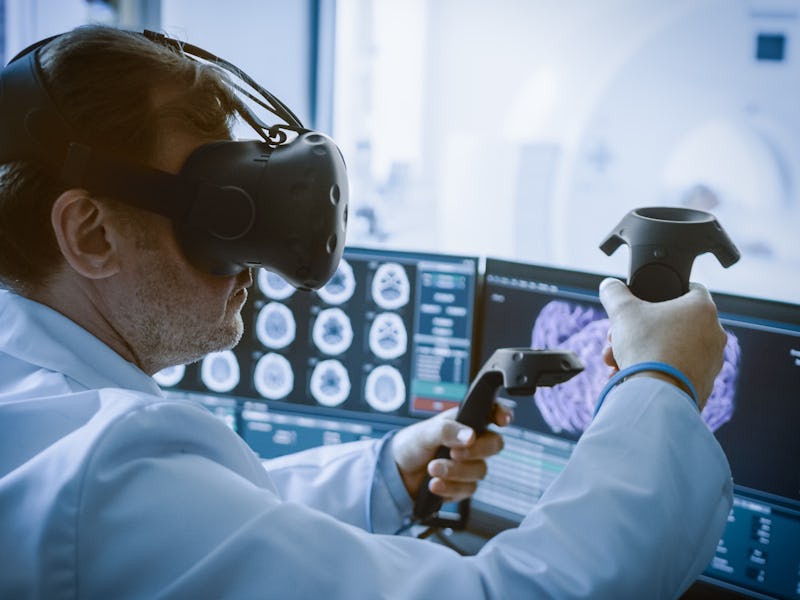Socially distant surgery is now possible nine miles away
Your next operation could be done by a remote-controlled robot doctor.

Surgery can be intimidating and hard to access at the best of times, but sky-rocketing Covid-19 cases in the U.S. have made getting non-essential surgeries not only dangerous but in some states, like Texas, completely inaccessible. Physicians in Italy might just have a solution in the form of a socially distant, 5G enabled surgery.
What's the news -- A new study published Monday in the journal Annals of Internal Medicine, a team of Italian physicians demonstrated that it was possible to successfully complete an invasive surgery on a patient from 9 miles (15 kilometers) away using remote-controlled robotic tools. While this team is not the first to ever complete telesurgery -- the first telesurgery was completed almost twenty-years ago in 2001 -- efforts in this field have been long stagnated by slow robotic and communication networks advances.
But thanks to the emergence of 5G, this surgery is now possible in a way it never was before, which could help make live-saving surgeries more accessible in remote parts of the world and even in space.
How does it work -- While the surgery itself was completed from nearly 10-miles away, the initial preparation for the surgery did take place at the hospital itself. Two local assistants first prepared a cadaver for surgery and also set the parameters for the remote tools that were to be used.
Thanks to the speed of 5G networks, physicians in Italy demonstrated the possibility of a socially distant surgery using VR goggles and a tablet.
With the "patient" prepped, a physician began conducting surgery on his vocal cords using remote-controlled forceps and lasers. On the surgeon's end, this looked like using VR goggles for 3D visualization of the operation and controlling the remote, robotic devices using a tablet and a haptic feedback device. For the patient, the surgery was carried out by a laser system, a robotic arm wielding forceps, and a 3D camera.
"If surgery can be performed robotically today, it can also be performed in telesurgery."
All commands to and from the patient and surgeon were transmitted by bouncing back and forth on a 5G network, similar to what you might use for high-download speeds on your phone.
Despite the obvious differences between this and traditional surgery, Leonardo Mattos, the lead author on the study and Head of the Biomedical Robotics Laboratory at the Italian Institute of Technology, tells Inverse that the surgeons who completed this remote operation reported feeling a strong sense of presence in the room.
"At this stage, the feeling is that of “telepresence," says Matos. "The surgeons describe feeling as if they were in the operating room during the delicate phases of tissue manipulation and laser ablation. Furthermore, they also describe feeling less stress during these delicate actions because the robotic devices provide great stability and smooth motions, allowing them to be more precise and confident during the operation."
"If surgery can be performed robotically today, it can also be performed in telesurgery."
What were the results -- Overall, the scientists were able to successfully complete the operation as they would have done in person and only experienced at most 280 milliseconds of lag between the surgeon's commands and the robot's actions.
While this operation focused on vocal cords, Mattos says there is little limitation to the kinds of surgery this approach could be used for.
"[T]he technology can be used for other types of laser surgery, or it can also be adapted for other types of robotic surgery," says Mattos. "Basically we could confidently claim that if a surgery can be performed robotically today, it can also be performed in telesurgery."
What's next -- The researchers write that the results of this study demonstrate how effective 5G communication can be in enabling these kinds of remote surgeries and even in the future teleassistance and telemonitoring of patients as well. The authors write that this could be an incredible tool for delivering care to remote field hospitals that may be otherwise challenging to access. But despite its potential benefits, Mattos tells Inverse there are still some kinks to work out.
"[The] system we developed and demonstrated in the 5G telesurgery scenario is still a proof-of-concept prototype. As such, it is still limited in many ways," says Mattos.
Mattos tells Inverse that this prototype is still several years away from human certification (hence, the cadaver) and runs the risk of dangerous signal drops during surgery. Mattos is confident that these issues can be overcome in the coming years but tells Inverse that legal and ethical repercussions might be the longer-lasting problem.
"The real bottleneck will surely be the legal and ethical issues remote telesurgery entails, especially when considering an international scenario."
Nevertheless, Mattos is excited about what the future of this technology will bring.
"This type of surgery has been a dream for many years given all the benefits it can provide," says Mattos. "The current pandemic also highlights the benefit of such technology to ensure the safe distancing between infected patients and the surgeon, contributing to safeguarding the health of critical medical personnel."
As a policy Inverse publishes the abstract to studies on which it reports, but this journal, Annals of Internal Medicine, did not publish an abstract with this research.